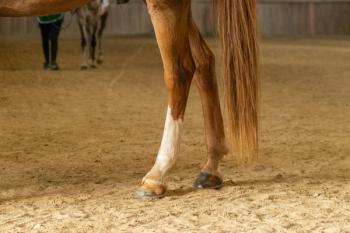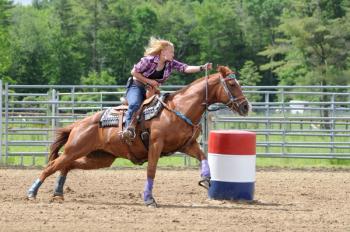
Hot Literature: Reaching the navicular from a different angle
A study in 11 clinically normal adult horses evaluated whether triamcinolone acetonide, a commonly used corticosteroid for treating navicular syndrome, would diffuse from the distal interphalangeal joint into the navicular bursa.
Navicular syndrome in horses is a tough veterinary treatment challenge. One way to relieve pain and reduce the inflammation associated with this condition is to inject a corticosteroid and hyaluronan-a combination that has excellent short-term and good long-term success rates-directly into the navicular bursa. Since navicular bursa injection is more difficult than distal interphalangeal joint (DIPJ) injection, treatment would be simpler if medications consistently passed through the biologic barrier between these two synovial spaces. The two spaces rarely communicate directly, but small molecular-weight substances will diffuse into the navicular bursa from the DIPJ. However, larger molecules such as hyaluronan cannot.
A study in 11 clinically normal adult horses evaluated whether triamcinolone acetonide, a commonly used corticosteroid for treating navicular syndrome, would diffuse from the DIPJ into the navicular bursa, whether the diffusion was direct or systemic, and whether adding hyaluronan would affect this diffusion.
The study was performed in two phases. First, triamcinolone plus lactated Ringer's solution was injected into the DIPJs of both forelimbs of seven horses. Synovial fluid was collected from the navicular bursae at 30 minutes and one, three, six, and nine hours after injection and evaluated to determine when the peak concentration of triamcinolone occurred. The triamcinolone concentration was highest in the navicular bursae six hours after DIPJ injection.
In the second phase, 11 horses had one forelimb DIPJ injected with triamcinolone plus lactated Ringer's solution and the other forelimb DIPJ injected with triamcinolone and hyaluronan. At six hours after injection, synovial fluid samples obtained from both forelimb navicular bursae and one hindlimb navicular bursa in each horse were evaluated. The hindlimb samples served as a systemic control group since some systemic absorption of triamcinolone occurs after articular injection.
Triamcinolone was not detected in pooled preinjection DIPJ samples from horses in the second phase of the study.Triamcinolone was detected in all the postinjection forelimb navicular bursae samples, and no significant difference was seen in triamcinolone concentrations between the forelimbs that received hyaluronan and those that did not. A significantly higher triamcinolone concentration was detected in the forelimb navicular bursae than in the hindlimb navicular bursae, representing a minor degree of systemic absorption. Navicular bursography performed after the injections revealed no direct communication between the DIPJ and navicular bursa.
While the individual synovial fluid triamcinolone concentrations varied widely, the results demonstrate that triamcinolone readily diffuses between the DIPJ and navicular bursa in clinically normal horses and that the addition of a high molecular-weight substance does not affect this movement. These results pave the way for further research into the effects, both positive and negative, of navicular syndrome on synovial membrane permeability, hyaluronan structure, and drug metabolism within an inflamed joint. Equine veterinary practitioners have long suspected a link, and there now appears to be a bit more data to support treating navicular syndrome via DIPJ injections.
Boyce M, Malone ED, Anderson LB, et al. Evaluation of diffusion of triamcinolone acetonide from the distal interphalangeal joint into the navicular bursa in horses. Am J Vet Res 2010;71(2):169-175.
Abstract available at
Newsletter
From exam room tips to practice management insights, get trusted veterinary news delivered straight to your inbox—subscribe to dvm360.






